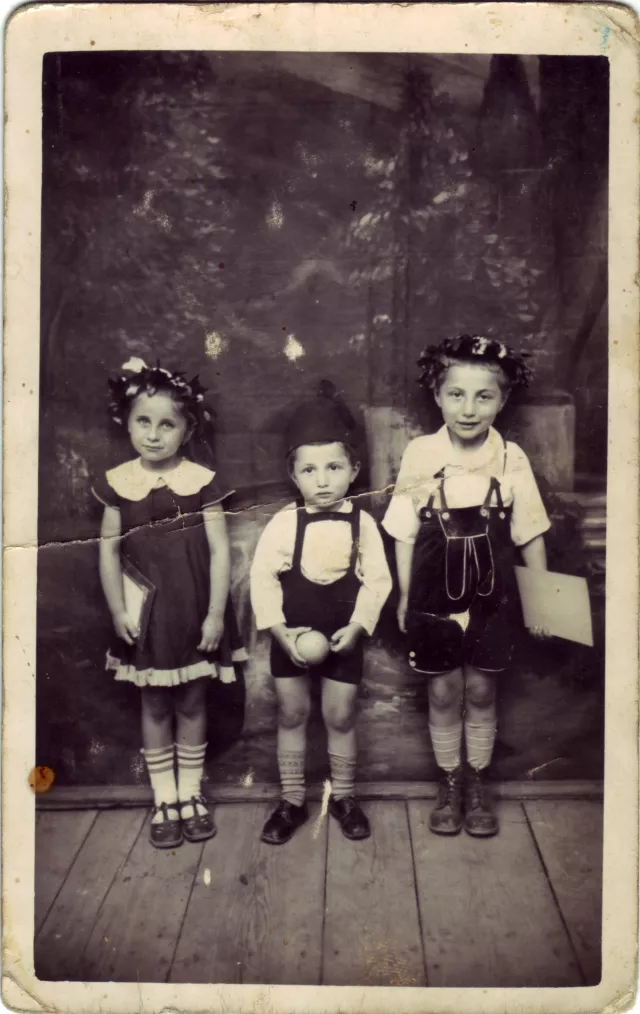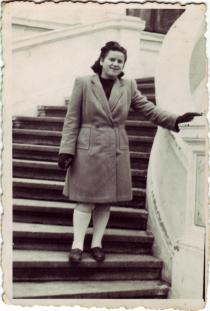The one to the left is my little sister Rozica Calmanovici and the others are my two little cousins, Iancu and Froim Mendelovici, sons of my mother’s sister, Branica. Froim is the one to the right. He and my sister had just finished first grade. They both got a flower coronet for their results. And they also got a book, see? Look at how proud she looks! This was a Bordeaux red dress with a white collar. She was so pretty. The boys used to wear striped velvet pants, as far as I remember. The back of the picture reads: “A souvenir from Calmanovici Rozica, Botosani, at the age of 6”.
The one to the left is my little sister Rozica Calmanovici and the others are my two little cousins, Iancu and Froim Mendelovici, sons of my mother’s sister, Branica. Froim is the one to the right. He and my sister had just finished first grade. They both got a flower coronet for their results. And they also got a book, see? Look at how proud she looks! This was a Bordeaux red dress with a white collar. She was so pretty. The boys used to wear striped velvet pants, as far as I remember. The back of the picture reads: “A souvenir from Calmanovici Rozica, Botosani, at the age of 6”.
I had a little sister, Rozica, who was 9 years younger than me, she was born in 1937. She died in 1947, she was almost 11, she had just graduated 4th grade of primary school. Had we found some sulphamid back then in Botosani, perhaps we might have saved her. She contracted typhoid fever. This was after the war, it was that drought, we had no money…
Branica was one of my mother’s sisters, Brana Mendelovici – born Mattes, changed her name to Mendelovici after she married. Her husband’s name was Heinic Mendelovici, and they had 2 sons: Froim and Iancu. Froim was the same age as my younger sister, so he was born in 1937, and Iancu was a few years younger, I think he was born in 1940. They lived in Frumusica, my aunt married a man from Frumusica – near Sulita. [Frumusica is located 27 km south of Sulita, 39 km south-east of Botosani.] My uncle was a merchant as well, he too had a manufacture store, he sold shoes in Frumusica. [When they came] In Botosani, they probably had gold coins, I couldn’t say for sure, I don’t know about that, they kept it a secret from me, and they bought sheep, they kept them close to Botosani. And he was more well-off than us, and he helped us. My mother’s sister, Branica, died in 1946, and after that my uncle got married again with another woman named Augusta, a very nice woman. And Heinic and Gusta, his new wife, left to Venezuela with their 2 sons, I believe it was in 1953 or 1954. Gusta had brothers there who owned gold mines. And I believe they paid a fortune, I couldn’t know how much they paid. For you had to pay for the retrieval [that is, you paid in order to leave the country]. And I so wanted to know how much they had to pay, but I don’t know to this day. [Ed. note: It is not likely that Venezuela paid Romania for the Jewish emigrants, rather the people paid a sum so that the Romanian authority let hem leave. “By 1950, in spite of immigration restrictions, there were around 6,000 Jewish people in Venezuela. The biggest waves of immigration occurred after World War II.” http://en.wikipedia.org/wiki/History_of_the_Jews_in_Venezuela]. And they had another son in Venezuela. But their third son left to Israel, he didn’t want to live in Venezuela. He’s not relative of mine, I have nothing to do with him, yet I visited him in Israel.





































